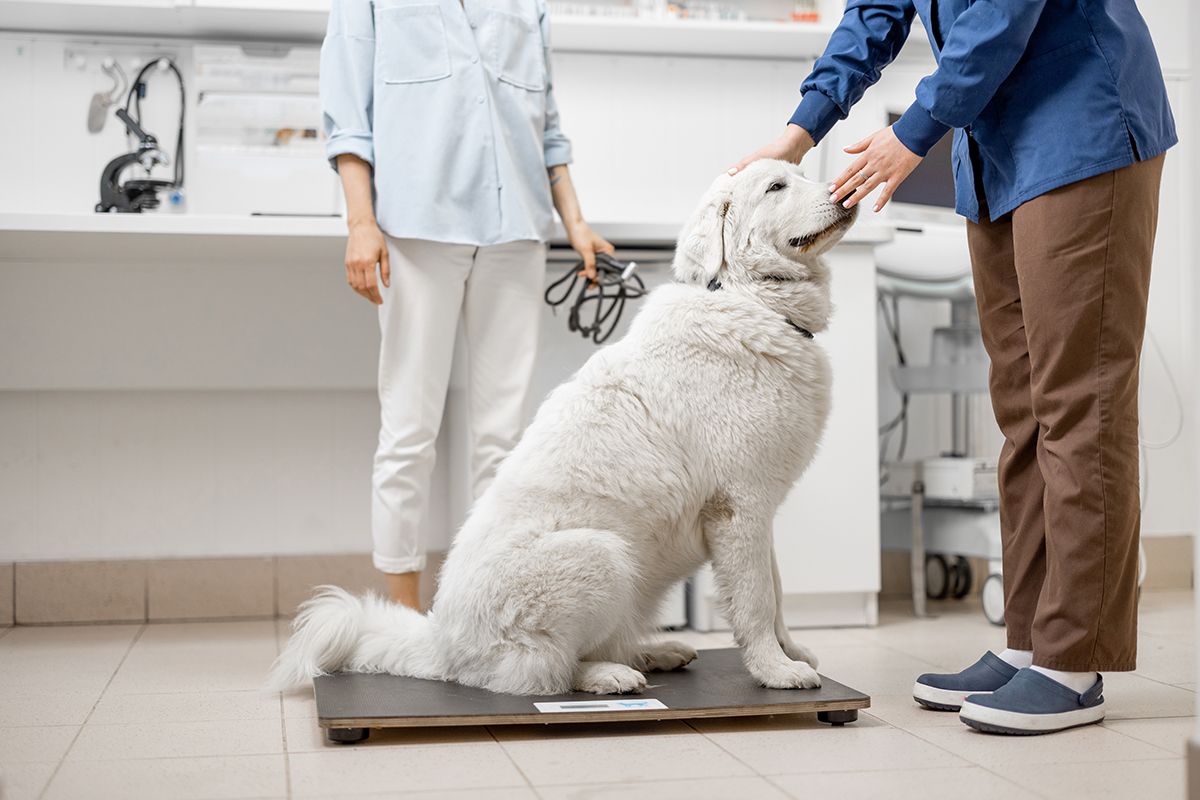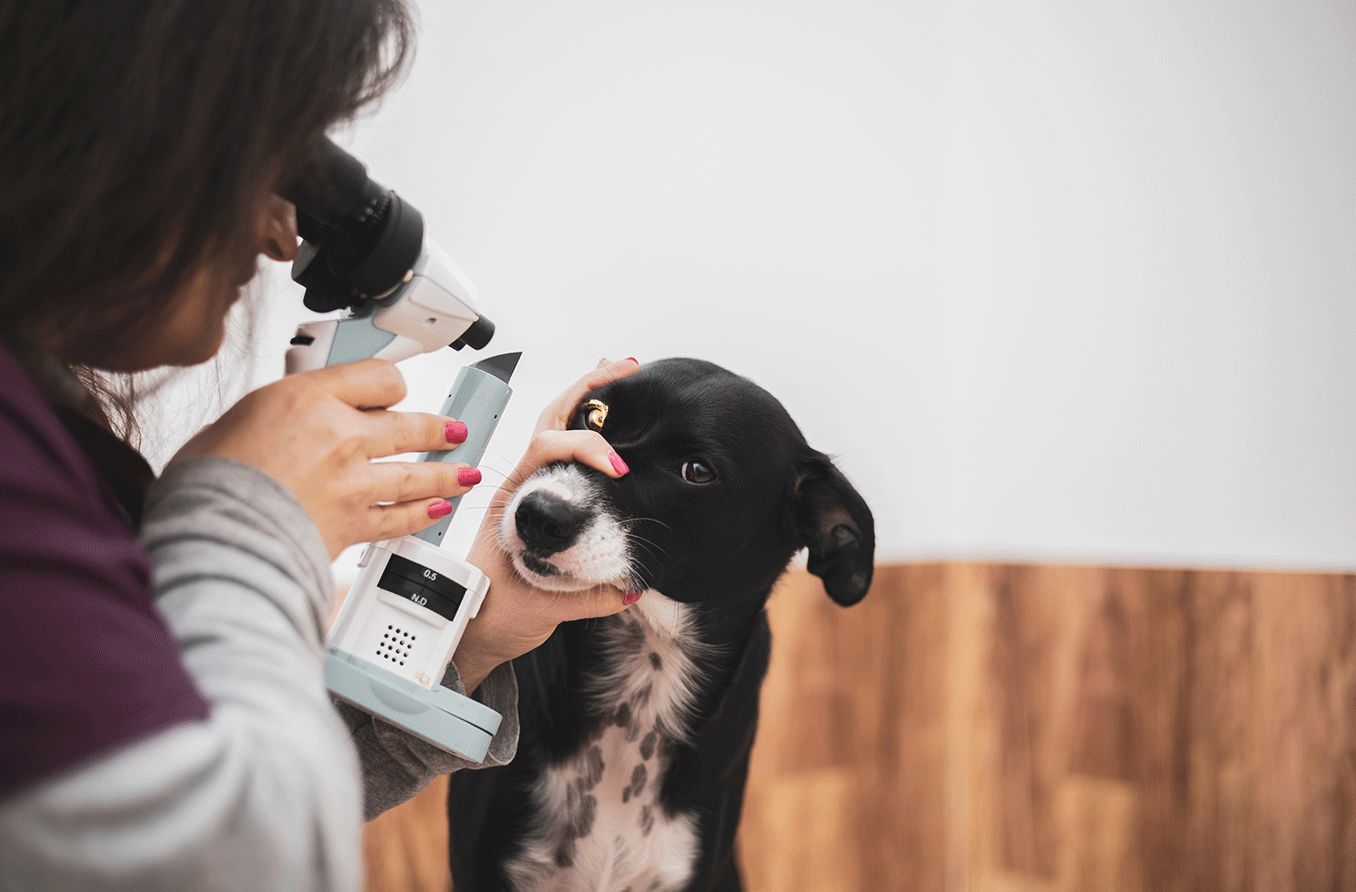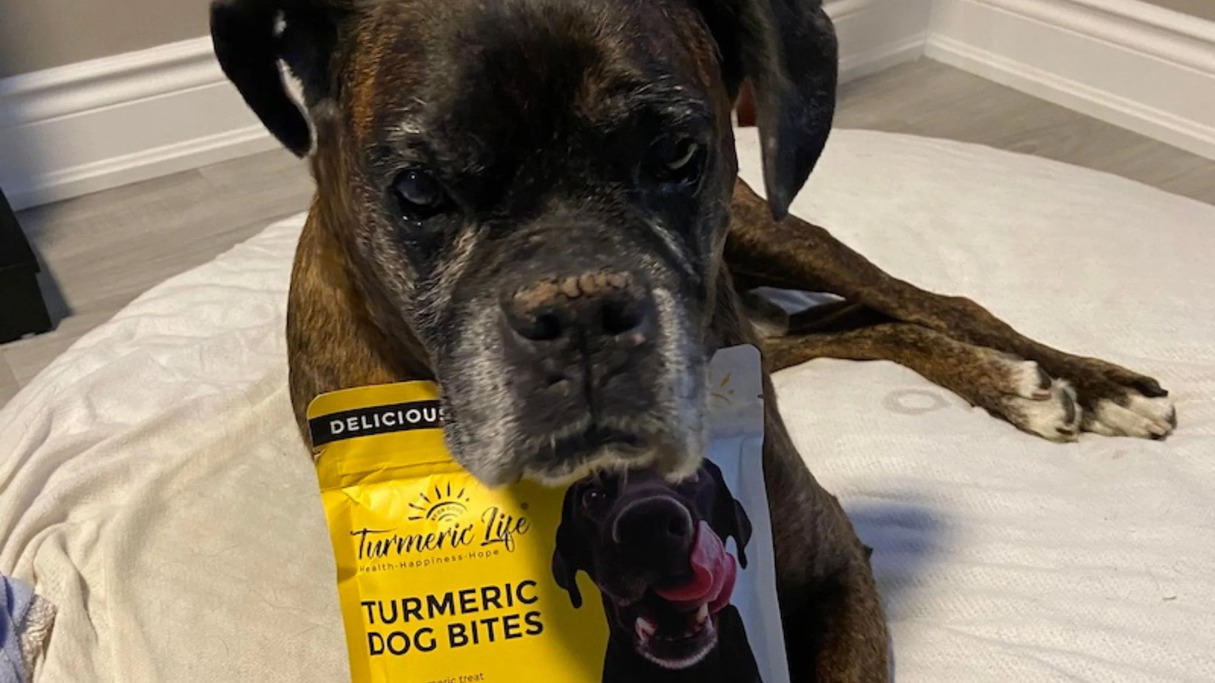Home>Health & Wellness>Nutrition & Diet>How To Control Obesity In Dogs


Nutrition & Diet
How To Control Obesity In Dogs
Published: February 1, 2024
Learn how to manage obesity in dogs through proper nutrition and diet. Discover effective strategies to help your dog achieve a healthy weight.
(Many of the links in this article redirect to a specific reviewed product. Your purchase of these products through affiliate links helps to generate commission for Pawsomeoldies.com, at no extra cost. Learn more)
Table of Contents
Introduction
Obesity is a prevalent issue not only among humans but also among our beloved canine companions. As pet owners, it's crucial to recognize the significance of maintaining a healthy weight for our dogs. Just like in humans, obesity in dogs can lead to a myriad of health problems, impacting their overall well-being and longevity. Therefore, understanding the causes, risks, and preventive measures for obesity in dogs is paramount.
In this comprehensive guide, we will delve into the various aspects of obesity in dogs, including its causes, associated health risks, and most importantly, how to prevent and control it. By gaining a deeper understanding of this issue, we can take proactive steps to ensure our furry friends lead happy, healthy lives.
Understanding the factors contributing to obesity in dogs and learning how to effectively manage their weight is essential for every pet owner. Through a combination of proper nutrition, regular exercise, and attentive care, we can help our dogs maintain an optimal weight and reduce the likelihood of obesity-related health complications. Let's embark on this enlightening journey to safeguard the well-being of our canine companions.
Read more: How To Care For A Dog With Arthritis
Understanding Obesity in Dogs
Obesity in dogs is a condition characterized by an excessive accumulation of body fat, leading to an increase in overall body weight. Just like in humans, obesity in dogs is a complex and multifaceted issue that can significantly impact their health and quality of life. It is important to recognize that obesity is not solely a cosmetic concern; rather, it poses serious health risks and can shorten a dog's lifespan.
One of the key factors in understanding obesity in dogs is recognizing the ideal body condition for different breeds. Each breed has its own unique physique, and what may be considered a healthy weight for one breed could be excessive for another. Factors such as age, sex, and activity level also play a crucial role in determining a dog's ideal weight.
Obesity often develops gradually and can be influenced by various factors, including overfeeding, lack of exercise, genetic predisposition, and certain medical conditions. It's essential for pet owners to be mindful of their dog's dietary habits and overall lifestyle to prevent the onset of obesity.
Furthermore, understanding the body composition of dogs is vital in addressing obesity. Excess weight can strain the musculoskeletal system, leading to joint pain, arthritis, and decreased mobility. Additionally, obesity can exacerbate existing health issues such as respiratory problems, diabetes, and cardiovascular diseases.
By comprehending the intricacies of obesity in dogs, pet owners can proactively take steps to prevent this condition and ensure the overall well-being of their furry companions. This includes being attentive to their dog's dietary needs, providing regular exercise, and seeking guidance from veterinarians to establish a tailored approach to weight management.
In essence, understanding obesity in dogs goes beyond mere physical appearance; it encompasses a holistic understanding of a dog's health and the proactive measures required to maintain an optimal weight. Through education and awareness, pet owners can play a pivotal role in combating obesity and promoting the longevity and vitality of their canine friends.
Causes of Obesity in Dogs
Obesity in dogs can stem from various contributing factors, many of which are within the control of pet owners. Understanding these causes is pivotal in addressing and preventing obesity in our canine companions.
-
Overfeeding: One of the primary causes of obesity in dogs is overfeeding. This can result from generous portion sizes, frequent treats, or an inability to resist those pleading puppy-dog eyes. It's important to adhere to recommended feeding guidelines and resist the temptation to overindulge our furry friends.
-
Lack of Exercise: Inadequate physical activity is another leading cause of obesity in dogs. A sedentary lifestyle coupled with excessive calorie intake can lead to weight gain. Dogs, like humans, require regular exercise to maintain a healthy weight and overall well-being.
-
Poor Diet Choices: The quality and quantity of food provided to dogs play a significant role in their weight management. Feeding high-calorie, low-nutrient foods or excessive table scraps can contribute to obesity. Additionally, the frequency of feeding and the type of food offered can impact a dog's weight.
-
Breed Predisposition: Certain dog breeds are more susceptible to weight gain and obesity due to genetic factors. Breeds such as Labrador Retrievers, Beagles, and Cocker Spaniels are known to have a higher predisposition to obesity. Understanding breed-specific tendencies can help pet owners proactively manage their dog's weight.
-
Age and Hormonal Changes: As dogs age, their metabolism may slow down, making it easier for them to gain weight. Hormonal changes, such as those associated with spaying or neutering, can also affect a dog's metabolism and appetite, potentially leading to weight gain if dietary adjustments are not made.
-
Medical Conditions: Certain medical conditions, such as hypothyroidism and Cushing's disease, can contribute to weight gain in dogs. It's essential for pet owners to work closely with veterinarians to address any underlying health issues that may impact their dog's weight.
By recognizing these causes of obesity in dogs, pet owners can take proactive measures to mitigate these factors and promote a healthy weight for their furry companions. Through mindful feeding, regular exercise, and attentive care, the risk of obesity in dogs can be significantly reduced, ensuring their overall well-being and vitality.
Health Risks of Obesity in Dogs
Obesity in dogs poses a multitude of health risks that can significantly impact their overall well-being and quality of life. Understanding these risks is crucial for pet owners to comprehend the severity of this condition and take proactive measures to address it.
One of the most immediate health risks of obesity in dogs is the strain it places on their musculoskeletal system. Excess weight can lead to joint pain, arthritis, and decreased mobility, significantly impacting a dog's ability to move comfortably and engage in physical activities. This can diminish their quality of life and lead to a sedentary lifestyle, further exacerbating the issue.
Furthermore, obesity in dogs can have detrimental effects on their respiratory system. Excess body fat can compress the chest cavity, making it difficult for dogs to breathe properly, especially during physical exertion or in warm weather. This can lead to respiratory distress, decreased stamina, and an overall reduced tolerance for exercise, further perpetuating the cycle of weight gain and decreased activity.
Obesity also predisposes dogs to an increased risk of developing various medical conditions, including diabetes mellitus, which can have serious implications for their health. The excess body fat can disrupt the normal functioning of insulin, leading to insulin resistance and diabetes. Managing diabetes in dogs requires diligent monitoring, medication, and lifestyle modifications, imposing a significant burden on both the dog and the pet owner.
Moreover, obese dogs are at a higher risk of developing cardiovascular diseases, such as hypertension, heart disease, and atherosclerosis. The strain on the heart and blood vessels due to excess body fat can lead to elevated blood pressure and an increased workload on the cardiovascular system, predisposing dogs to potentially life-threatening conditions.
In addition to the physical health risks, obesity in dogs can also impact their mental and emotional well-being. Reduced mobility, chronic pain, and the inability to engage in normal activities can lead to decreased overall happiness and an increased likelihood of behavioral issues.
By recognizing these health risks, pet owners can gain a deeper understanding of the detrimental effects of obesity on their canine companions. Taking proactive steps to prevent and address obesity through proper nutrition, regular exercise, and attentive care is essential in safeguarding the health and vitality of dogs, ensuring they lead fulfilling and active lives.
How to Prevent Obesity in Dogs
Preventing obesity in dogs is a proactive and multifaceted endeavor that encompasses various aspects of their daily care and lifestyle. By implementing the following preventive measures, pet owners can significantly reduce the risk of obesity and promote the overall health and well-being of their canine companions.
Read more: How To Prevent Arthritis In Dogs
Mindful Feeding Practices
Ensuring that dogs receive appropriate portion sizes and a balanced diet is fundamental in preventing obesity. Pet owners should adhere to feeding guidelines provided by veterinarians or pet nutritionists, taking into account the dog's age, size, activity level, and specific dietary needs. Additionally, avoiding excessive treats and table scraps is crucial in maintaining a healthy weight for dogs.
Regular Exercise Regimen
Incorporating regular exercise into a dog's daily routine is essential for preventing obesity. Engaging in activities such as brisk walks, interactive play sessions, and mental stimulation exercises not only helps burn calories but also promotes physical fitness and mental well-being. Tailoring the exercise regimen to the dog's breed, age, and overall health is key to ensuring it is both enjoyable and beneficial.
Nutrient-Dense and Balanced Diet
Providing dogs with high-quality, nutrient-dense food that aligns with their specific nutritional requirements is vital in preventing obesity. Opting for premium dog food that offers a balanced combination of proteins, carbohydrates, fats, vitamins, and minerals can support optimal health and weight management. Additionally, avoiding free-feeding and establishing regular mealtimes can help regulate calorie intake.
Portion Control and Monitoring
Practicing portion control and closely monitoring the dog's weight and body condition is imperative in preventing obesity. Measuring food portions accurately and adjusting them based on the dog's activity level and weight management goals can help prevent overfeeding. Regularly assessing the dog's body condition through visual and tactile examinations can aid in identifying any fluctuations in weight.
Read more: How To Supplement Taurine In A Dog’s Diet
Consistent Veterinary Care
Regular veterinary check-ups are essential for preventing obesity in dogs. Veterinarians can provide valuable insights into the dog's overall health, weight management strategies, and any potential health concerns that may impact their weight. Establishing an open line of communication with the veterinarian allows for collaborative efforts in maintaining the dog's optimal weight and well-being.
By integrating these preventive measures into the daily care and lifestyle of dogs, pet owners can effectively mitigate the risk of obesity and promote a healthy weight. Through mindful feeding practices, regular exercise, and attentive monitoring, dogs can thrive and lead active, fulfilling lives, free from the detrimental effects of obesity.
Tips for Controlling Obesity in Dogs
Controlling obesity in dogs requires a holistic approach that encompasses various strategies to promote weight management and overall well-being. By implementing the following tips, pet owners can effectively address obesity in their canine companions and foster a healthy lifestyle.
1. Consult with a Veterinarian
Initiating a weight management plan for an obese dog should begin with a comprehensive consultation with a veterinarian. A veterinarian can assess the dog's current weight, body condition, and overall health status. They can also provide tailored recommendations for dietary adjustments, exercise regimens, and monitoring protocols based on the dog's specific needs.
2. Implement Portion Control
Careful portion control is essential in managing a dog's weight. Measuring food portions accurately and adhering to recommended feeding guidelines can prevent overfeeding and excessive calorie intake. Additionally, incorporating specialized weight management diets, formulated to provide satiety while controlling calorie intake, can support the dog's weight loss journey.
Read more: How To Safely Rinse A Dog’s Eye
3. Incorporate Regular Exercise
Regular physical activity is crucial for dogs combating obesity. Engaging in daily exercise routines, such as brisk walks, interactive play sessions, and agility training, can help burn calories, improve muscle tone, and enhance overall fitness. Tailoring the exercise regimen to the dog's abilities and gradually increasing activity levels can ensure a safe and sustainable approach to weight management.
4. Utilize Interactive Feeding Methods
Introducing interactive feeding methods, such as puzzle feeders and food-dispensing toys, can encourage dogs to engage in mental and physical stimulation while eating. This not only slows down their eating pace but also provides cognitive enrichment, promoting a healthier relationship with food and reducing the likelihood of overeating.
5. Monitor Progress and Adjust Accordingly
Consistent monitoring of the dog's weight, body condition, and overall progress is essential in controlling obesity. Regular weigh-ins and body condition assessments can help track the effectiveness of the weight management plan. Based on the progress, adjustments to the diet, exercise routine, and portion sizes can be made to ensure steady and sustainable weight loss.
6. Seek Behavioral and Emotional Support
Addressing obesity in dogs may also involve addressing behavioral and emotional factors related to food and eating habits. Seeking guidance from professional animal behaviorists or certified dog trainers can help identify and address any underlying behavioral issues that may contribute to overeating or sedentary behavior.
Read more: How Much Is Arthritis Medicine For Dogs
7. Foster a Supportive Environment
Creating a supportive and encouraging environment for an obese dog is crucial for their weight management journey. Providing ample opportunities for physical activity, positive reinforcement during training and exercise, and maintaining a consistent routine can contribute to the dog's overall well-being and success in controlling obesity.
By implementing these tips for controlling obesity in dogs, pet owners can actively support their canine companions in achieving and maintaining a healthy weight. Through a combination of tailored nutrition, regular exercise, and attentive care, dogs can overcome obesity and thrive, leading active and fulfilling lives.
Exercise and Activity Recommendations
Regular exercise is a cornerstone of maintaining a healthy weight and overall well-being for dogs. Implementing a tailored exercise regimen that aligns with a dog's breed, age, and physical capabilities is essential in combating obesity and promoting physical fitness. Here are comprehensive exercise and activity recommendations to support weight management and vitality in dogs:
1. Tailored Exercise Plans
Designing a customized exercise plan that suits the specific needs and abilities of the dog is paramount. Different breeds have varying exercise requirements, with some requiring more vigorous activities while others may thrive with moderate exercise. Understanding the breed-specific traits and energy levels can aid in tailoring an exercise regimen that is both enjoyable and beneficial for the dog.
2. Daily Walks and Outdoor Activities
Incorporating daily walks into a dog's routine provides essential physical activity and mental stimulation. Outdoor activities such as hiking, running, or playing fetch in a secure area can offer opportunities for dogs to engage in natural behaviors, expend energy, and maintain a healthy weight. Varying the walking routes and introducing new environments can also stimulate the dog's senses and prevent monotony.
Read more: How To Help Dogs With Anxiety At Night
3. Interactive Play Sessions
Engaging in interactive play sessions with dogs not only fosters a strong bond but also promotes physical activity. Toys such as balls, frisbees, and tug ropes can facilitate active play, encouraging dogs to run, jump, and engage in dynamic movements. Interactive play sessions are not only physically stimulating but also provide mental enrichment, contributing to a well-rounded exercise routine.
4. Canine Sports and Agility Training
Participating in canine sports and agility training can offer a structured and engaging form of exercise for dogs. Activities such as agility courses, obedience training, and canine sports competitions provide opportunities for dogs to showcase their physical prowess while engaging in a challenging and rewarding activity. These activities not only promote physical fitness but also enhance the dog's coordination and mental acuity.
5. Swimming and Water Activities
For dogs that enjoy water, swimming and water activities can provide low-impact yet highly effective exercise. Swimming offers a full-body workout, engaging various muscle groups while being gentle on the joints. Introducing dogs to water-based activities, such as retrieving toys from the water or engaging in supervised swimming sessions, can offer a refreshing and beneficial form of exercise.
6. Mental Stimulation Exercises
Incorporating mental stimulation exercises, such as scent work, puzzle toys, and obedience training, can complement physical exercise routines. Mental stimulation not only keeps dogs intellectually engaged but also contributes to their overall well-being. Engaging in activities that challenge the dog's problem-solving skills and cognitive abilities can provide a holistic approach to exercise and mental enrichment.
By integrating these exercise and activity recommendations into a dog's daily routine, pet owners can effectively support weight management and promote physical fitness. Tailoring the exercise regimen to the dog's individual needs, providing diverse and stimulating activities, and ensuring consistency in physical engagement can contribute to combating obesity and fostering a healthy, active lifestyle for dogs.
Diet and Nutrition Guidelines
Proper diet and nutrition play a pivotal role in managing a dog's weight and overall health. By adhering to specific guidelines and making informed dietary choices, pet owners can effectively support weight management and promote optimal well-being for their canine companions.
Balanced and Nutrient-Dense Diet
Providing dogs with a balanced and nutrient-dense diet is fundamental in maintaining a healthy weight. High-quality commercial dog foods that are formulated to meet the nutritional needs of dogs can serve as the foundation of their diet. Opting for premium dog food that contains a balanced combination of proteins, carbohydrates, fats, vitamins, and minerals is essential for supporting overall health and weight management.
Portion Control and Feeding Frequency
Practicing portion control and establishing regular feeding times are crucial in preventing overfeeding and excessive calorie intake. Measuring food portions accurately based on the dog's size, age, and activity level can help regulate calorie consumption. Additionally, dividing the daily food allowance into multiple small meals can prevent hunger-induced overeating and support a consistent energy level throughout the day.
Weight Management and Specialized Diets
For dogs requiring weight management support, specialized weight loss diets formulated to provide satiety while controlling calorie intake can be beneficial. These diets are designed to promote gradual and sustainable weight loss while ensuring that essential nutrients are adequately provided. Consulting with a veterinarian or pet nutritionist to determine the most suitable weight management diet for the dog's specific needs is essential.
Read more: How Much Tramadol For Dog Cancer
Avoidance of High-Calorie Treats and Table Scraps
Limiting the intake of high-calorie treats and table scraps is essential in maintaining a healthy weight for dogs. While treats can be used as occasional rewards, it's important to choose low-calorie, nutritious options and incorporate them into the dog's daily calorie allowance. Avoiding excessive indulgence in high-calorie treats and table scraps can prevent unnecessary calorie intake and support weight management efforts.
Hydration and Water Accessibility
Ensuring that dogs have constant access to fresh, clean water is essential for their overall health and well-being. Adequate hydration supports proper digestion, nutrient absorption, and metabolic function. Pet owners should regularly check and refill water bowls to guarantee that their dogs remain adequately hydrated throughout the day.
By following these diet and nutrition guidelines, pet owners can actively contribute to the weight management and overall health of their dogs. Tailoring the diet to meet the dog's specific nutritional requirements, practicing portion control, and making informed dietary choices can significantly impact the dog's weight and well-being. Additionally, seeking guidance from veterinarians or pet nutritionists can provide valuable insights and support in establishing a tailored nutrition plan for dogs.
Monitoring and Managing Weight
Monitoring and managing a dog's weight is a continuous and proactive process that requires attentiveness and dedication from pet owners. By implementing effective strategies and maintaining a vigilant approach, pet owners can play a pivotal role in ensuring their dog maintains an optimal weight and overall well-being.
Regular Weigh-Ins: Periodic weigh-ins at home or during veterinary visits are essential for monitoring a dog's weight. Keeping track of any fluctuations in weight can provide valuable insights into the effectiveness of the weight management plan. It also allows pet owners to identify any concerning trends and take timely action.
Body Condition Assessments: Conducting visual and tactile assessments of the dog's body condition is crucial in determining whether the dog is at an ideal weight. By evaluating the dog's body shape, feeling for the presence of excess fat, and assessing overall muscle tone, pet owners can gain a deeper understanding of the dog's physical condition.
Adjusting Portion Sizes: Based on the dog's weight and body condition, pet owners may need to adjust food portion sizes to support weight management. Working closely with veterinarians to determine the appropriate caloric intake and making necessary adjustments can ensure that the dog receives the right amount of food to maintain a healthy weight.
Consistent Exercise Regimen: Monitoring the dog's exercise routine and ensuring consistent physical activity is vital for managing weight. By tracking the duration and intensity of exercise sessions, pet owners can ensure that the dog receives adequate physical stimulation to support weight management and overall fitness.
Consulting with Veterinarians: Regular consultations with veterinarians provide valuable opportunities to discuss the dog's weight management progress and address any concerns. Veterinarians can offer tailored recommendations, assess the dog's overall health, and provide guidance on adjusting the weight management plan as needed.
Behavioral Observations: Observing the dog's behavior, energy levels, and appetite can offer insights into their overall well-being and the effectiveness of the weight management plan. Changes in behavior or appetite may indicate the need for adjustments in the diet, exercise routine, or overall care.
By actively monitoring and managing a dog's weight through these comprehensive strategies, pet owners can contribute to the dog's long-term health and vitality. Consistency, attentiveness, and collaboration with veterinary professionals are key in ensuring that the dog maintains an optimal weight and enjoys a fulfilling and active lifestyle.
Conclusion
In conclusion, addressing and preventing obesity in dogs is a multifaceted endeavor that requires a holistic approach encompassing proper nutrition, regular exercise, and attentive care. Obesity in dogs poses significant health risks, including musculoskeletal strain, respiratory difficulties, and increased susceptibility to various medical conditions. By understanding the causes and health implications of obesity, pet owners can proactively take steps to prevent and manage this condition.
Implementing mindful feeding practices, portion control, and balanced nutrition is fundamental in preventing obesity in dogs. Adhering to feeding guidelines, choosing high-quality, nutrient-dense food, and avoiding excessive treats and table scraps can support weight management efforts. Additionally, incorporating regular exercise tailored to the dog's breed, age, and physical capabilities is essential for promoting physical fitness and preventing weight gain.
Monitoring the dog's weight, body condition, and overall progress is crucial for managing obesity. Regular weigh-ins, body condition assessments, and adjustments to portion sizes and exercise regimens are integral components of effective weight management. Seeking guidance from veterinarians and maintaining open communication regarding the dog's health and progress can provide valuable support in combating obesity.
Ultimately, by fostering a supportive environment, providing consistent care, and being proactive in addressing obesity, pet owners can significantly impact the well-being and longevity of their canine companions. Through education, awareness, and a commitment to promoting a healthy lifestyle, dogs can thrive, maintain an optimal weight, and enjoy active, fulfilling lives free from the detrimental effects of obesity.








